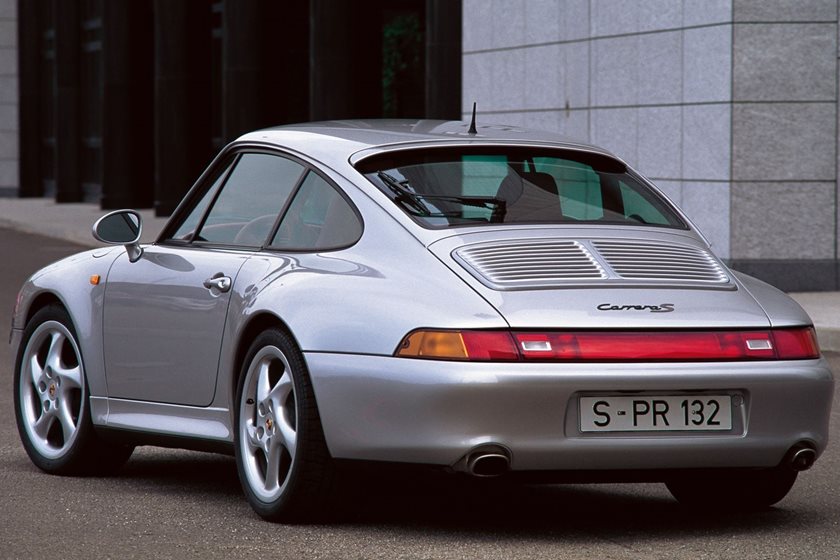Ah the Porsche 911, we have read endless reports of how this rear-engined icon has rocketed in value in recent years and that there are no more good value alternatives out there, save perhaps for the previously unloved water-cooled 996. In truth there is nothing much wrong with these cars, the facelifted 996 is an accomplished sportscar and from a purely financial standpoint they do make a strong case for themselves. But even if you have no issue with the looks or mechanical issues that affected the early cars, you know the one you really want is the 993.
 Let us explain...
Let us explain...Compared to the 996, it has less power, still features parts carried over from the original 911 and the dashboard is clearly a product of an ergonomic madman. And yet, of all the 911s before or since, the 993 is the one that best embodies the essence of the brand. We won’t delve into the special edition cars like GT3s and RS models too much as these tend to have long since moved into the unaffordable category. It’s totally fine if you are skeptical, but keep reading, by the time you are done you too will see the light.
 The first Porsche 911: 1963-1973
The first Porsche 911: 1963-1973These early 'pre-impact bumper 'cars have gone up most in value in recent years. The demand for clean, unmodified examples has seen prices for even the most basic variants reach crazy heights. Now there's nothing wrong with a proper old-school 911 except that it is old. This is not the kind of car that you would take on a cross-country road trip regardless of what diehard owners say. They do immerse you into the driving experience like nothing else though, but seeing as you can spend well over $200,000 on a good one, the time to buy one was 10-years ago.

 Porsche 911 Carrera: 1974-1989
Porsche 911 Carrera: 1974-1989The 911 was upgraded with new ‘impact’ bumpers in 1974. The change got about as much backlash as the announcement of water-cooling and turbocharging did and these cars used to be the affordable entry-point into the brand. Not anymore. Even the leaky Targa is now commanding big numbers. The best ones were the last Carrera 3.2 variants. With the G50 gearbox and over a decade of fettling, they offer the best impact bumper experience. Still, with most producing around 220 hp, they aren’t exactly quick. The Turbos are fast but they will spit you into the bushes and cost more than your house.

 Porsche 911 (964): 1989-1993
Porsche 911 (964): 1989-1993The 964 was a big step up from the long-running Carrera. All-wheel-drive was introduced for the first time (developed first in the 959 supercar) and a Tiptronic automatic transmission was added too. The engine was upgraded with the 250-hp 3.6-liter flat-six enough to get you to 60 mph in 5.5 seconds. Good Carrera 2s and 4s start at $50,000, convertibles and Tiptronics are usually a bit cheaper. The 964 is a decent modern classic, its biggest issue is that it is priced too closely to the superior 993. Many also end up as retromods. That said, the Carrera RS is awesome but massively overpriced.

 Porsche 911 (996 and 997): 1998-2012
Porsche 911 (996 and 997): 1998-2012The 996 has received a lot of attention lately. At first it was because issues with the IMS shaft and RMS seals had caused some catastrophic engine failures. Once this was resolved (and people realized the issue had been vastly overblown) the focus shifted instead to what great deals these cars can be. It is true that an early 996 can be found for as little as $15,000 but would you still buy one if it wasn’t so cheap? The 997 looked far better although under the skin things were much the same. The facelifted post-2009 997.2 models finally resolved the IMS/RMS issues but those models are still pricey and haven’t quite entered into the modern classic phase yet.

 The Modern Era: Porsche 911 (991)
The Modern Era: Porsche 911 (991)The latest 911s are from another planet when it comes to handling and performance. The turbocharged engines are lag free and provide huge lumps of torque at virtually any engine speed. The engine has slowly inched its way forward to improve handling while the front end displays none of that high-speed floating that was such a defining character of the older models. Prices start at around $85,000 and go up to $200,000 for the mental GT2 RS. The 991 R is impressive too but factor in the inevitable new-car depreciation and the 993 starts to make a whole lot more sense.

 Back To The Porsche 911 (993): 1994-1998
Back To The Porsche 911 (993): 1994-1998So, to our preferred choice. Looks are a subjective thing but there is something just right about the 993’s proportions. It also has just the right amount of power to keep you entertained. Early cars had 268 hp which rose to 281 hp from 1996-on with the addition of the Variocam system. A new multilink rear suspension also further reduced any tail happy tendencies. Look hard enough and there are still some very decent, clean 993s out there for under $50,000. That’s half the price of a modern 911 and you can almost guarantee that in five-years’ time that situation will be reversed.


There may be cheaper, faster and more practical 911s out there but when taken as an overall package, the 993 is currently occupying that sweet spot that few classic cars achieve. It appeals to traditionalist air-cooled fans while still being modern enough to be desirable to younger car fans too. Turbo and RS models are targeted at wealthy collectors but the base Carrera, especially in RWD manual form is as sweet as ever. As an investment, driving tool and piece of automotive history, there surely can’t be anything else out there that can compete with the superb 993.



Comments
Post a Comment